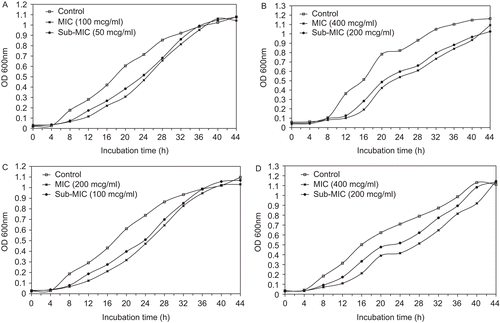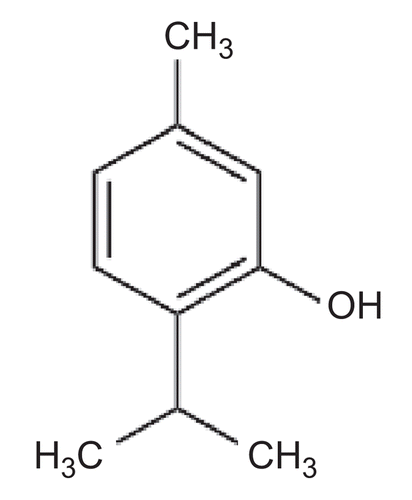Abstract
The antibacterial activity of thymol has been well established and reported in the scientific literature. Continued suppression of bacterial growth following limited exposure to antimicrobial compounds at different concentrations greater than or equal to the minimum inhibitory concentration level (MIC) and at concentrations less than the MIC can be used as an indicator of biological activity, and are respectively referred to as a post-antibacterial effect (PAE) and a post-antibiotic sub-MIC effect (PA-SME). In this study, the PAE and the PA-SME of thymol against Escherichia coli, Staphylococcus aureus, Pseudomonas aeruginosa, and Bacillus cereus were investigated. A spectrophotometric method was used to determine the PAE and the PA-SME of thymol against the selected test strains. Thymol exhibited a considerable PAE and PA-SME at MIC and sub-MIC concentrations against test strains. The greatest duration of both the PAE and the PA-SME was observed for thymol against E. coli and P. aeruginosa. The PAE and PA-SME times for E. coli were 12 and 8 h, respectively, and for P. aeruginosa were 11 and 7.5 h, respectively. The duration of the PAE and PA-SME observed for S. aureus and B. cereus was shorter than for Gram-negative strains.
Introduction
Increasing interest exists in the use of monoterpenes in natural medicine as antibacterial agents and resistance modulators (CitationMoleyar & Narasimham, 1986; CitationBaca et al., 2002; CitationRamsewak et al., 2003; CitationTrombetta et al., 2005; CitationValero & Francés, 2006; CitationAbdolpour et al., 2007; CitationRafii & Shahverdi, 2007). Thymol, a phenolic monoterpene (), is found in the essential oils of different plants such as Thymus vulgaris L. (Laminaceae), Monarda didyma L. (Laminaceae), and Monarda fistulosa L. (Laminaceae) (CitationBhaskara et al., 1998; CitationJohnson et al., 1998; CitationSavickiene et al., 2002). Currently, this plant-based volatile compound is synthesized abundantly and used as a preservative or a potent antibacterial ingredient in food or pharmaceutical dosage forms (CitationManou et al., 2002; CitationBurt, 2004). For example, thymol as a solution in oil of 1 or 2%, is applied to the respiratory passages by means of a spray in nasal catarrh. Also, an alcohol solution may be inhaled from hot water for bronchial and laryngitis care. Although the antibacterial activity of thymol has been studied extensively against different bacteria (CitationPharmaceutical Society of Great Britain, 1911; CitationTippayatum & Chonhenchob, 2007), the post-antibacterial activity of this compound is not yet understood. In this study, the post-antibacterial activity of thymol was investigated against Escherichia coli (ATCC 11345), Staphylococcus aureus (ATCC 29737), Pseudomonas aeruginosa (ATCC 12432), and Bacillus cereus (ATCC 16754). Continued suppression of bacterial growth following limited exposure to antimicrobial compounds at different concentrations [greater than or equal to the minimum inhibitory concentration (MIC) level] can be used as an indicator of biological activity and is termed the post-antibacterial effect (PAE) (CitationOdenholt-Tornqvist, 1993; CitationJacobs et al., 2003). Conversely, the post-antibacterial sub-MIC effect (PA-SME), which defines the effect of sub-inhibitory concentrations (less than the MIC level) of the agent, increases the effect of the agent and further decreases the dosing interval (Rotschafer et al., Citation1994).
Materials and methods
Antibacterial susceptibility and PAE and PA-SME assays
Susceptibility tests were conducted by the standard broth dilution method in accordance with the CitationNational Committee for Clinical Laboratory Standards (2008) in Müller–Hinton broth (MHB) with an inoculum of approximately 105 colony-forming units (CFU)/mL. Standard test strains listed in were used. The MHB was supplemented with thymol (Sigma Aldrich, Steinheim, Germany), concentrations ranging from 100 to 800 µg/mL. Data are reported as MIC values, the lowest concentration of thymol inhibiting visible growth after 24 h of incubation at 37°C.
Table 1. The antibacterial effect and post-antibacterial duration of thymol against different test strains.
The PAE and PA-SME of thymol were determined separately by the following method (CitationOdenholt-Tornqvist, 1993). The test strains were incubated separately in the presence of thymol (at MIC and one-half MIC concentrations) for 90 min. Subsequently, tested compounds were removed by centrifugation of the culture followed by two washes with 10 mL of thymol in pre-warmed MHB. The pellets were re-suspended in 30 mL of thymol-free, pre-warmed MHB to determine the PAE and PA-SME. MHB culture media were inoculated under the same conditions to constitute a thymol-free control. All culture media were incubated at 37°C for 24 h. The optical densities (ODs) of culture media were measured at 600 nm at different intervals (0–48 h after re-suspension). The PAE and PA-SME periods were calculated according to CitationOdenholt-Tornqvist (1993), i.e., the time required for antibiotic-treated cultures to reach 50% of the ODmax of the control culture, minus the time required for the control culture to reach the same point (CitationOdenholt-Tornqvist, 1993).
Results and discussion
The MICs of thymol for different test strains are reported in . Different test strains exhibited varied susceptibility to thymol. The greatest susceptibility was observed for thymol against the Gram-positive bacteria B. cereus (MIC = 100 µg/mL) and S. aureus (MIC = 200 µg/mL). The antibacterial effect of thymol is well known and reported in the literature, and this research confirmed previous results (CitationTippayatum & Chonhenchob, 2007). The effects of thymol at different concentrations (MIC and one-half MIC) on the reduction of bacterial growth of the test strains after a short exposure time are illustrated in . The durations of the PAE and PA-SME of thymol against test strains at the MIC and one-half MIC concentrations are also reported in . The greatest durations of PAE and PA-SME were observed for thymol against E. coli and P. aeruginosa. The PAE and PAE-SME times for E. coli were 12 and 8 h, respectively, and for P. aeruginosa were 11 and 7.5 h, respectively ().
Figure 2. The post-antibacterial effect and post-antibiotic sub-MIC effect of thymol against (A) Bacillus cereus, (B) Pseudomonas aeruginosa, (C) Staphylococcus aureus, and (D) Escherichia coli.

The durations of the PAE and the PA-SME observed for S. aureus and B. cereus were less than observed for Gram-negative strains (). The antibacterial activity of thymol against different test strains has been reported in the literature (CitationTippayatum & Chonhenchob, 2007), but the PAE and the PA-SME of this natural product has not been investigated previously. To the best of our knowledge, based on a survey of the literature, this is the first finding on the PAE and PA-SME effects of thymol. Determination of the PAE is an important factor that influences optimal antimicrobial dosing intervals. Conversely, antibacterial agents without a PAE usually require more frequent administration than agents exhibiting PAEs. In this study, the post-antibacterial effect of thymol at concentrations of MIC (PAE) and sub-MIC (PA-SME) were investigated against different test strains. Thymol exhibited considerable PAE and PA-SME effects at the concentrations tested against the selected strains.
Declaration of interest
This work was supported by the Pharmaceutical Sciences Research Center, Faculty of Pharmacy, Tehran University of Medical Sciences, Tehran, Iran.
References
- Abdolpour F, Shahverdi AR, Rafii F, Fazeli MR, Amini M (2007): Effects of piperitone on the antimicrobial activity of nitrofurantoin and on nitrofurantoin metabolism by Enterobacter cloacae. Pharm Biol 45: 230–234.
- Baca P, Muñoz MJ, Bravo M, Junco P, Baca AP (2002): Effectiveness of chlorhexidine-thymol varnish for caries reduction in permanent first molars of 6–7-year-old children: 24-month clinical trial. Community Dent Oral Epidemiol 30: 363–368.
- Bhaskara MV, Angers P, Gosselin A, Arul J (1998): Characterization and use of essential oil from Thymus vulgaris against Botrytis cinerea and Rhizopus stolonifer in strawberry fruits. Phytochemistry 47: 1515–1520.
- Burt S (2004): Essential oils: Their antibacterial properties and potential applications in foods--a review. Int J Food Microbiol 94: 223–253.
- Jacobs MR, Bajaksouzian S, Peter C (2003) Appelbaum telithromycin post-antibiotic and post-antibiotic sub-MIC effects for 10 Gram-positive cocci. J Antimicrob Chemother 52: 809–812.
- Johnson HA, Rogers LL, Alkire ML, McCloudand TG, McLaughlin JL (1998): Bioactive monoterpenes from Monarda fistulosa (Lamiaceae). Nat Prod Res 11: 241–250.
- Manou I, Bouillard L, Devleeschouwer MJ, Barel AO (2002): Evaluation of the preservative properties of Thymus vulgaris essential oil in topically applied formulations under a challenge test. J Appl Microbiol 84: 368–376.
- Moleyar V, Narasimham P (1986): Antifungal activity of some essential oil components. Food Microbiol 3: 331–336.
- National Committee for Clinical Laboratory Standards (2008): Performance Standards for Antimicrobial Susceptibility Testing; Ninth Informational Supplement. NCCLS document M100-S9. Wayne, PA, National Committee for Clinical Laboratory Standards.
- Odenholt-Tornqvist I (1993): Studies on the postantibiotic effect and the postantibiotic sub-MIC effect of meropenem. J Antimicrob Chemother 31: 881–892.
- Pharmaceutical Society of Great Britain (1911): The British Pharmaceutical Codex, 1911: An Imperial Dispensatory for the Use of Medical Practitioners and Pharmacists. London, Pharmaceutical Society of Great Britain, pp. 1568.
- Rafii F, Shahverdi AR (2007): Comparison of essential oils from three plants for enhancement of antimicrobial activity of nitrofurantoin against enterobacteria. Chemotherapy 53: 21–25.
- Ramsewak RS, Nair MG, Stommel M, Selanders L (2003): In vitro antagonistic activity of monoterpenes and their mixtures against “toe nail fungus” pathogen. Phytother Res 17: 376–379.
- Rotschafer JC, Walker KJ, Kelly KJ, Sullivan CJ (1994): Antibiotic pharmacodynamics. In: Cutler NR, Sramek JJ, Narang PK, eds., Pharmacodynamics and Drug Development: Perspectives in Clinical Pharmacology. Chichester, John Wiley and Sons, pp. 315–345.
- Savickiene N, Dagilyte A, Barsteigiene Z, Kazlauskas S, Vaiciūniene J (2002): Analysis of flavonoids in the flowers and leaves of Monarda didyma L. Medicina 38:1119–1122.
- Tippayatum P, Chonhenchob V (2007): Antibacterial activities of thymol, eugenol and nisin against some food spoilage bacteria. Kasetsart J (Nat Sci) 41: 319–323.
- Trombetta D, Castelli F, Sarpietro MG, Venuti V, Cristani M, Daniele C, Saija A, Mazzanti G, Bisignano G (2005): Mechanisms of antibacterial action of three monoterpenes. Antimicrob Agents Chemother 49: 2474–2478.
- Valero M, Francés E (2006): Synergistic bactericidal effect of carvacrol, cinnamaldehyde or thymol and refrigeration to inhibit Bacillus cereus in carrot broth. Food Microbiol 23: 68–73.

